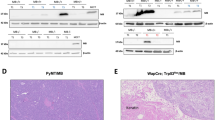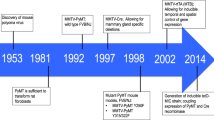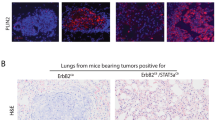Abstract
Maspin is a unique serpin involved in the suppression of tumor growth and metastasis. To investigate whether increased levels of maspin protect against tumor progression in vivo, we established a transgenic model in which maspin is targeted to mammary epithelial cells by the Whey Acidic Protein (WAP) promoter for overexpression. We crossed these WAP-maspin transgenic mice with the WAP-TAg mouse model of tumor progression. Maspin overexpression increased the rate of apoptosis of both preneoplastic and carcinomatous mammary epithelial cells. Maspin reduced tumor growth through a combination of reduced angiogenesis and increased apoptosis. The number of pulmonary metastases was reduced in the presence of maspin overexpression. These data demonstrate that targeted overexpression of maspin can inhibit tumor progression in vivo, likely through a combination of increased apoptosis, decreased angiogenesis, and inhibition of tumor cell migration.
This is a preview of subscription content, access via your institution
Access options
Subscribe to this journal
Receive 50 print issues and online access
$259.00 per year
only $5.18 per issue
Buy this article
- Purchase on Springer Link
- Instant access to full article PDF
Prices may be subject to local taxes which are calculated during checkout




Similar content being viewed by others
References
Domann FE, Rice JC, Hendrix MJ and Futscher BW. . 2000 Int. J. Cancer 85: 805–810.
Dyson N, Buchkovich K, Whyte P and Harlow E. . 1989 Cell 58: 249–255.
Faraldo MM, Deugnier MA, Lukashev M, Thiery JP and Glukhova MA. . 1998 EMBO J. 17: 2139–2147.
Hendrix MJ. . 2000 Nat. Med. 6: 374–376.
Lee EY, To H, Shew JY, Bookstein R, Scully P and Lee WH. . 1988 Science 241: 218–221.
Li M, Hu J, Heermeier K, Hennighausen L and Furth PA. . 1996 Cell. Growth Differ. 7: 3–11.
Li M, Lewis B, Capuco AV, Laucirica R and Furth PA. . 2000 Oncogene 19: 1010–1019.
Mietz JA, Unger T, Huibregtse JM and Howley PM. . 1992 EMBO J. 11: 5013–5020.
Obermair A, Bancher-Todesca D, Bilgi S, Kaider A, Kohlberger P, Mullauer-Ertl S, Leodolter S and Gitsch G. . 1997 J. Natl. Cancer Inst. 89: 1212–1217.
Pemberton PA, Tipton AR, Pavloff N, Smith J, Erickson JR, Mouchabeck ZM and Kiefer MC. . 1997 J. Histochem. Cytochem. 45: 1697–1706.
Pemberton PA, Wong DT, Gibson HL, Kiefer MC, Fitzpatrick PA, Sager R and Barr PJ. . 1995 J. Biol. Chem. 270: 15832–15837.
Sager R, Sheng S, Anisowicz A, Sotiropoulou G, Zou Z, Stenman G, Swisshelm K, Chen Z, Hendrix MJ, Pemberton P, Rafidi K and Ryan K. . 1994 Cold Spring Harb. Symp. Quant. Biol. 59: 537–546.
Sager R, Sheng S, Pemberton P and Hendrix MJ. . 1996 Curn. Top. Microbiol. Immunol. 213: 51–64.
Seftor RE, Seftor EA, Sheng S, Pemberton PA, Sager R and Hendrix MJ. . 1998 Cancer Res. 58: 5681–5685.
Sheng S, Carey J, Seftor EA, Dias L, Hendrix MJ and Sager R. . 1996 Proc. Natl. Acad. Sci. USA 93: 11669–11674.
Sheng S, Pemberton PA and Sager R. . 1994 J. Biol. Chem. 269: 30988–30993.
Sternlicht MD, Kedeshian P, Shao ZM, Safarians S and Barsky SH. . 1997 Clin. Cancer Res. 3: 1949–1958.
Tsujii M, Kawano S, Tsuji S, Sawaoka H, Hori M and DuBois RN. . 1998 Cell 93: 705–716.
Tzeng YJ, Guhl E, Graessmann M and Graessmann A. . 1993 Oncogene 8: 1965–1971.
Xia W, Lau YK, Hu MC, Li L, Johnston DA, Sheng S, El-Naggar A and Hung MC. . 2000 Oncogene 19: 2398–2403.
Zhang M, Maass N, Magit D and Sager R. . 1997a Cell. Growth. Differ. 8: 179–186.
Zhang M, Magit D, Botteri F, Shi Y, He K, Li M, Furth P and Sager R. . 1999 Developmental. Biology. 215: 278–287.
Zhang M, Magit D and Sager R. . 1997b Proc. Natl. Acad. Sci. USA 94: 5673–5678.
Zhang M, Sheng S, Maass N and Sager R. . 1997c Mol. Med. 3: 49–59.
Zhang M, Volpert O, Shi YH and Bouck N. . 2000 Nat. Med. 6: 196–199.
Zou Z, Anisowicz A, Hendrix MJ, Thor A, Neveu M, Sheng S, Rafidi K, Seftor E and Sager R. . 1994 Science 263: 526–529.
Zou Z, Gao C, Nagaich AK, Connell T, Saito S, Moul JW, Seth P, Appella E and Srivastava S. . 2000 J. Biol. Chem. 275: 6051–6054.
Acknowledgements
We thank Dr Arthur Pardee at Dana Farber Cancer Institute for his generous support. We are very grateful to Dr Florence Botteri at Fredrich Miser Institute for her input to this study. This work is supported by grants DAMD17-98-1-8028 and CA79736 to M. Zhang.
Author information
Authors and Affiliations
Rights and permissions
About this article
Cite this article
Zhang, M., Shi, Y., Magit, D. et al. Reduced mammary tumor progression in WAP-TAg/WAP-maspin bitransgenic mice. Oncogene 19, 6053–6058 (2000). https://doi.org/10.1038/sj.onc.1204006
Received:
Revised:
Accepted:
Published:
Issue Date:
DOI: https://doi.org/10.1038/sj.onc.1204006
Keywords
This article is cited by
-
Maspin suppresses cell invasion and migration in gastric cancer through inhibiting EMT and angiogenesis via ITGB1/FAK pathway
Human Cell (2020)
-
Maspin: molecular mechanisms and therapeutic implications
Cancer and Metastasis Reviews (2012)
-
The Role of Cathepsins in Involution and Breast Cancer
Journal of Mammary Gland Biology and Neoplasia (2009)
-
Nuclear cytokine-activated IKKα controls prostate cancer metastasis by repressing Maspin
Nature (2007)
-
Re-activation of a dormant tumor suppressor gene maspin by designed transcription factors
Oncogene (2007)



